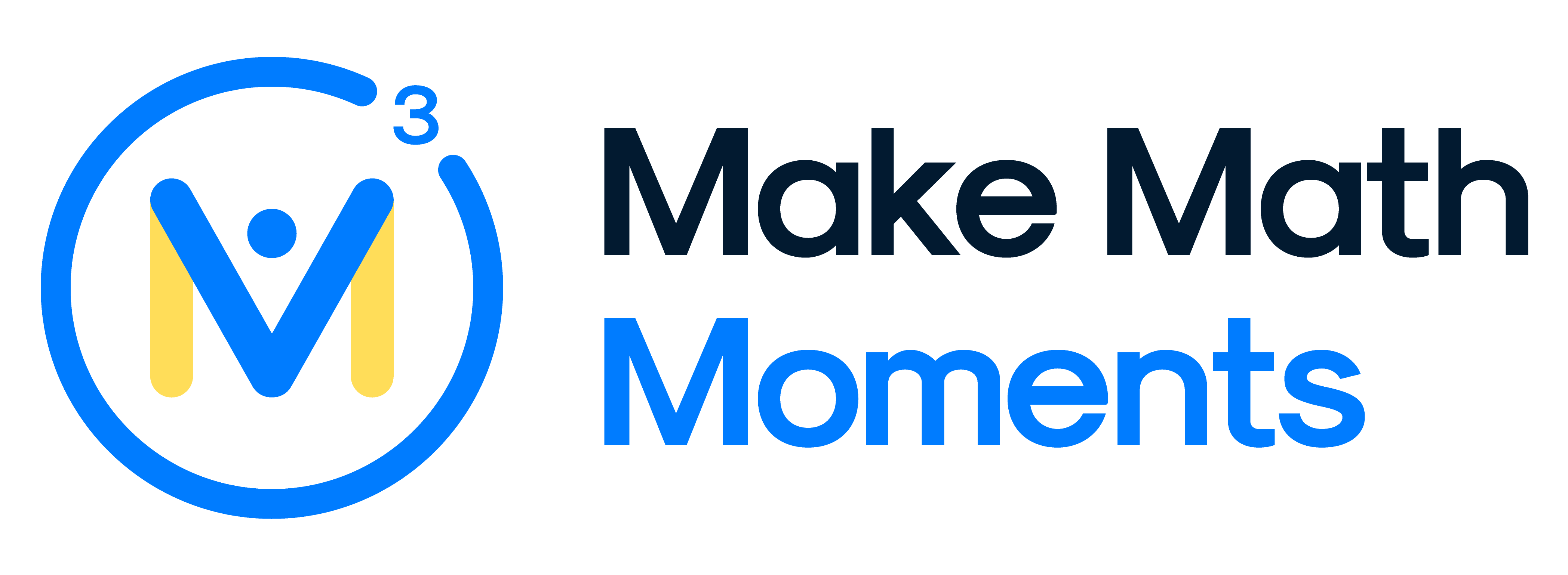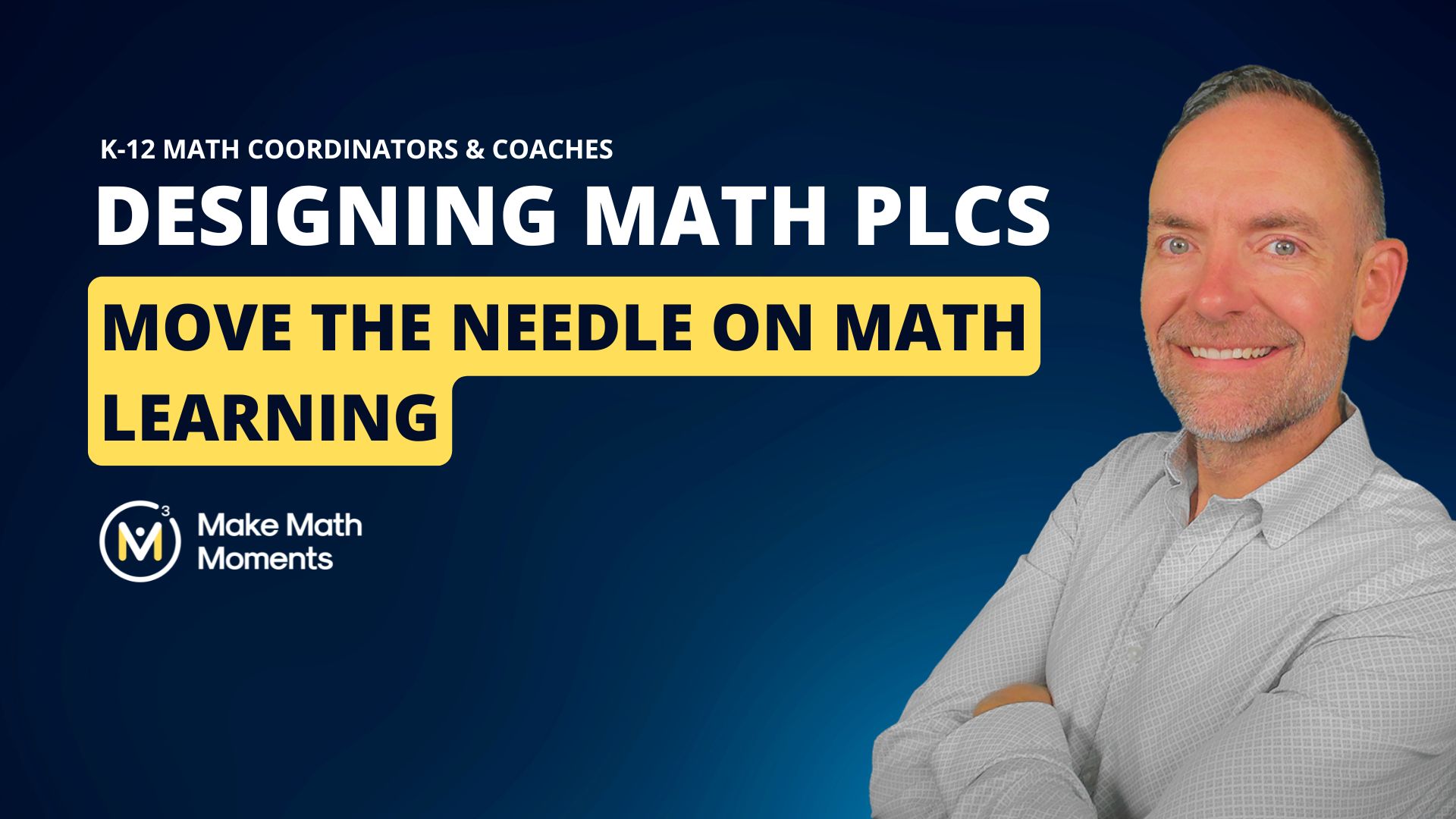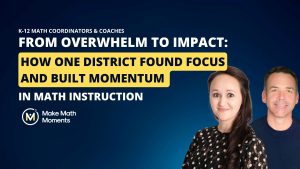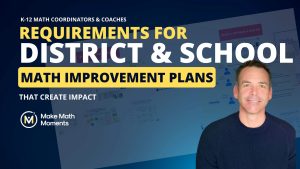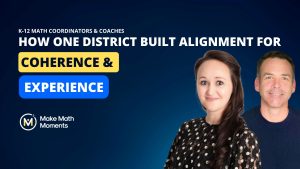When one instructional coach reached out to us from a mid-sized district in the Midwest, she didn’t mince words: “We’re in a math emergency.”
Despite sincere efforts across the district—like implementing high-quality resources, launching book studies on Building Thinking Classrooms, and offering various PD sessions—students weren’t making the gains the team had hoped for. PLC meetings, while well-intentioned, often drifted into logistical chatter or resource complaints rather than deep instructional work. Teachers weren’t always clear on what was most important to focus on, and there wasn’t a consistent structure to help them get there.
“We needed a plan,” the coach told us. “And we needed it to stick.”
Step One: Define the Purpose
We began by working with the team to surface the real purpose of PLC time—not just to collaborate, but to grow. Together, we aligned around three high-leverage goals for their PLCs:
- Build content knowledge in number sense and operations
- Strengthen purposeful questioning and discourse practices
- Embed number routines into the daily instructional flow
This aligned with DuFour et al.’s (2016) vision of PLCs as vehicles for focused, results-driven inquiry. The district leadership team embraced the idea that collaboration should lead to improved practice—and that meant clarity, structure, and coaching.
Step Two: Build the Structures
Next, we co-developed facilitation protocols that coaches could use to guide PLCs through standards analysis, lesson planning, and student work reflection. Instead of jumping from one topic to the next, teams began to focus on clearly defined targets. A consistent routine started to take hold: look at the data, reflect on instructional strategies, focus on the math, and adjust.
This shift was particularly powerful at the elementary level. Teachers had long been doing number talks and mini-lessons—just not with shared purpose. By narrowing the focus and having grade-level PLCs explore why students were struggling (not just what they were struggling with), teachers began to design instruction that addressed conceptual gaps, not just procedural ones.
Step Three: Focus on Fluency with Purpose
In the months that followed, the district team used their PLC time to zero in on fluency. Not just speed drills or fact memorization, but fluency as defined by efficiency, flexibility, and accuracy. As one coach reflected, “We realized our students were fluent with procedures but not always with understanding.”
By focusing on specific grade bands—like Grades 1–2 for addition and subtraction within 100—the district built a coherent progression of number sense instruction. Coaches used classroom videos, lesson debriefs, and in-the-moment coaching to support these shifts in real time.
Step Four: Align, Reflect, and Sustain
Throughout the year, instructional leaders met regularly to review data, revisit key results, and refine their support. They learned to ask better questions: Are PLCs moving teacher practice forward? Are our goals visible in the classroom? Do teachers know what success looks like?
This wasn’t easy work. Competing initiatives, staffing changes, and new systems meant the team had to stay nimble. But by anchoring their PLCs to a shared vision and leveraging coaching and leadership teams to guide the work, the district began turning fragmented collaboration into focused, sustained professional growth.
This district’s journey wasn’t about doing more—it was about doing better with the time they already had. Their success shows what’s possible when collaboration is focused, supported, and tied to a clear instructional vision. And they’re not the exception. Their story can be a model for any district ready to turn fragmented PLCs into a system-wide lever for change.
So how do you make that shift in your own district or school? Let’s explore how to design collaborative time that actually moves the needle on teacher practice and student learning.
How To Design & Lead Impactful Collaborative Time with Teachers
Professional Learning Communities (PLCs) and teacher collaboration time hold immense potential—but too often, they fall flat. Time may be allocated, educators show up, but real instructional, belief, and mathematical understanding shifts rarely take root.
Why? Because structure, clarity, and coherence are missing.
As a K–12 math coordinator, one of your roles is to design impactful routines and support, guide, and nurture teacher collaboration time. To ensure that every minute teachers spend together contributes to strengthening their mathematical and teaching “trees”: instructional alignment, content knowledge, beliefs and culture, and ultimately, student learning.
We’ve already seen that teachers rarely receive the amount of professional learning time research recommends. But just as concerning is how that time is traditionally used.
In a large-scale study of PLCs, only 24% of collaboration time was spent on instructional planning related to upcoming lessons (Cobb et al, 2018). The majority—over two-thirds—was consumed by logistics, scheduling, surface-level tips, and pacing decisions. Time that could be spent unpacking standards and connections to curriculum, analyzing student work, or strengthening pedagogical content knowledge is instead spent on what’s urgent—not what’s important.
And perhaps most glaring: almost none of that time was spent helping teachers deepen their mathematical understanding or rehearse instructional strategies before trying them in the classroom.
This misalignment doesn’t just water down the impact of PLCs—it sends the wrong message.
No wonder teachers dread collaborative time. Teachers show up hoping to grow, but instead they get pulled into calendar coordination, hallway duty assignments, or a vague conversation about what worksheet to use next week. To them, it’s mostly been another meeting that could have been conducted by sending out an email. In other words, a waste of time.
The opportunity is clear: when structured with intention and aligned with your district or school’s math goals, PLCs become the engine of sustainable instructional improvement. They are one of the only recurring structures in your system where teachers can work together to refine their practice in real time.
This post will show you how to make that happen.
You’ll learn how to:
- Align PLCs with your district’s math vision and coaching structures
- Use a structured, repeatable cycle grounded in student thinking
- Build capacity by training skilled facilitators
- Protect collaborative time and signal its importance
If your district or school is investing time into collaboration, don’t leave that time to chance. Design it. Protect it. Leverage it to build the momentum your classrooms need.
Making PLC Time Count
To understand the shift we’re aiming for, let’s compare what typically happens in many schools—the old way—to what research and experience tell us is needed—the new way.
| Old Way | New Way |
| PLCs focus on logistics: What’s being taught next week? What worksheet are you using? | PLCs focus on learning: unpacking standards, analyzing student thinking, and improving instruction. |
| Each PLC runs independently with little connection to district goals or coaching support. | PLCs are part of a coordinated system that aligns with district vision, coaching, and PD. |
| No clear facilitator; meetings are often teacher-led with varied levels of preparation or purpose. | Skilled facilitators (often coaches or trained leads) guide PLCs using consistent protocols. |
| Time is occasionally canceled, co-opted for admin tasks, or left unprotected. | Time is protected and treated as essential to school improvement. |
| Collaboration feels like an “add-on” to teachers’ real work. | Collaboration is the core method by which teachers plan, learn, and improve their practice. |
Start with the System: Aligning PLCs With Your Math Vision
One of the most common reasons PLCs feel scattered is that they’re disconnected from the larger system. When district PD, coaching, and PLCs aren’t aligned, teachers receive mixed messages and conflicting priorities.
“Professional learning is most effective when it is part of a coherent system of improvement focused on curriculum, instruction, and student learning.”
— Learning Forward, Standards for Professional Learning (2022)
If coaching is about one thing, and pull-out PD is about another, and the PLC is doing something else entirely… it’s no wonder teachers disengage.
As the math coordinator, your first responsibility is coherence. Ensure that the big ideas from district or school math PD show up in coaching conversations and are the same ones unpacked during PLC time. This means:
- Defining a clear math vision and 1–2 priority objectives for the year (Section 1 of this book).
- Ensuring you have skilled facilitators: training coaches and lead teachers on how to embed these priorities into PLCs.
- Creating a structure that repeats regularly enough for ideas to deepen and progress to be measured.
Use a Structured Cycle Grounded in Student Thinking
Whether you’re supporting a school’s weekly PLC or facilitating a district-wide collaboration session, the most effective designs share three traits:
- They center on a clear instructional goal.
- They focus on real student work.
- They follow a consistent, repeatable cycle.
Here’s a possible framework or agenda you could follow to meet those guidelines (See the full framework with examples here):
Week 1: Unpack the Standard & Set the Target
- Collaboratively unpack a focus standard. Make the connection to the school or district goal clear.
- Identify prerequisite skills and likely misconceptions.
- Teachers engage in any mathematical thinking required by students: Do the math!
- Co-construct a student learning goal and success criteria.
- Select or co-design a common formative assessment task.
Week 2: Analyze Student Work & Plan Instruction
- Bring samples from the common task.
- Moderate scoring using shared success criteria.
- Identify student strengths and misconceptions.
- Plan targeted instructional responses: small groups, models, re-teaching, extensions.
Week 3: Reflect on Instruction & Assess Impact
- Bring new work samples from students who were on the cusp of mastery.
- Reflect on what worked, what didn’t, and what changes improved learning.
- Capture insights for future units and adjust instructional approaches.
This cycle is simple, replicable, and adaptable to any grade level. Most importantly, it builds collective efficacy—teachers see their work improving outcomes together.
Staff Meetings as Professional Learning
Collaborative learning doesn’t have to be confined to PLC time. You can use full-staff meetings to deepen math content knowledge and promote cross-grade collaboration using this Staff Meeting Protocol – just as a number of leaders from Imagine Schools – South West Region have built into their culture – you can turn staff meetings into powerful collaboration learning spaces.
Each session follows a five-step arc:
- Set the Purpose – Introduce a key math idea across grades (e.g., proportional reasoning) – make the connection to the school or district goal clear.
- Do the Math – Teachers engage in a rich, conceptual task.
- Anticipate Student Thinking – Discuss expected strategies, misconceptions, and student entry points.
- Connect to Curriculum – Explore vertical alignment and implications for instruction.
- Reflect & Plan – Reflect on instructional use and make shared commitments.
This structure fosters deep mathematical understanding while honoring teachers’ desire to plan and prepare for their students.
Who Should Facilitate? You, Until You Don’t Have To
Research shows that skilled facilitation is the linchpin of effective collaboration (DuFour et al., 2016). Whether it’s you, a coach, or a trained lead teacher, there must be someone prepared to guide the group, connect the dots, and keep the work on track.
In the beginning, you may need to model this yourself. But long-term sustainability depends on identifying and developing new facilitators. Use collaboration as a leadership incubator. If we’re not intentionally building leaders, we’re building fragility.
Ask:
- Who already models strong math instruction?
- Who’s respected and collaborative?
- What support will they need to grow into this role?
Invest in them. Coach them. Pair them with you. Eventually, they’ll carry the work without you—and that’s the goal.
Protect the Time, Signal the Priority
If you say PLCs matter, then treat them like they matter.
That means:
- Avoiding schedule disruptions and cancellations.
- Not using the time for announcements or last-minute logistics.
- Showing up yourself—and encouraging admin to do the same.
As one administrator shared, “The minute I repurpose that time, I’ve told my staff that collaboration is optional.”
Instead, treat PLC time as the engine of instructional improvement. Signal that it’s a non-negotiable. And back it up with the structures and support teachers need to do their best thinking.
Final Thoughts
Effective PLCs don’t happen by chance. They happen because someone—often you—designed them that way.
As the math coordinator, you have the opportunity to transform collaboration from a routine obligation into the most powerful form of professional learning in your system. That transformation begins with alignment. When PLCs are clearly connected to your district’s math vision, teachers understand not just what to work on—but why it matters.
But vision alone isn’t enough. The most impactful PLCs follow a consistent structure—one rooted in curriculum standards, assessment evidence, and real student thinking. This consistency helps teams move beyond surface-level planning into deeper reflection on instruction.
Of course, strong collaboration also depends on strong facilitation. Whether it’s an experienced coach or an emerging teacher-leader, someone must be equipped to guide the process, keep the focus tight, and connect each conversation back to instructional priorities. As a leader, your job is to build that capacity—by modeling it, coaching into it, and supporting it system-wide.
And finally, none of this happens without protected time. Collaboration can’t be treated as extra. When it’s seen as essential—as part of the job, not on top of it—teachers engage more deeply, and the work becomes sustainable.
When these elements are in place, PLCs stop being “just another meeting.” They become the heartbeat of your district’s math improvement plan—a place where teachers grow, ideas evolve, and students benefit.
If you’re planning for next year and want your coaching program to drive measurable change—not just activity—let’s talk.
➡️ Book a call with our team, and we’ll walk through how to design a focused, research-backed PLC structure that aligns with your goals and builds lasting momentum.
References:
Cobb, Paul, Kara Jackson, Erin Henrick, and Thomas M. Smith. Systems for Instructional Improvement: Creating Coherence from the Classroom to the District Office. Harvard Education Press, 2021.
👉 https://www.hepg.org/hep-home/books/systems-for-instructional-improvement
DuFour, Richard, Robert Eaker, Rebecca DuFour, and Thomas W. Many. Learning by Doing: A Handbook for Professional Learning Communities at Work. 3rd ed., Solution Tree Press, 2016.
Learning Forward. Standards for Professional Learning. Learning Forward, 2022. https://standards.learningforward.org
